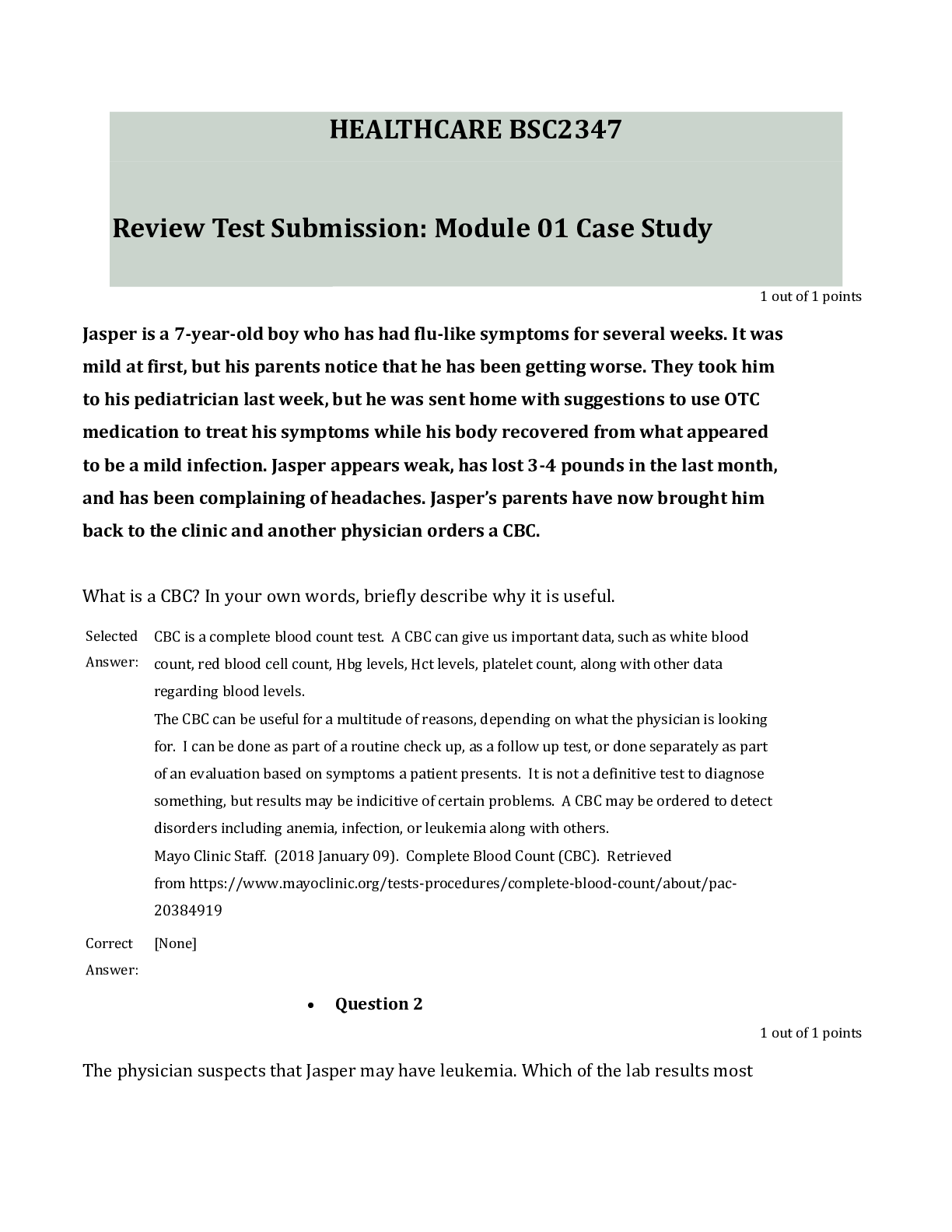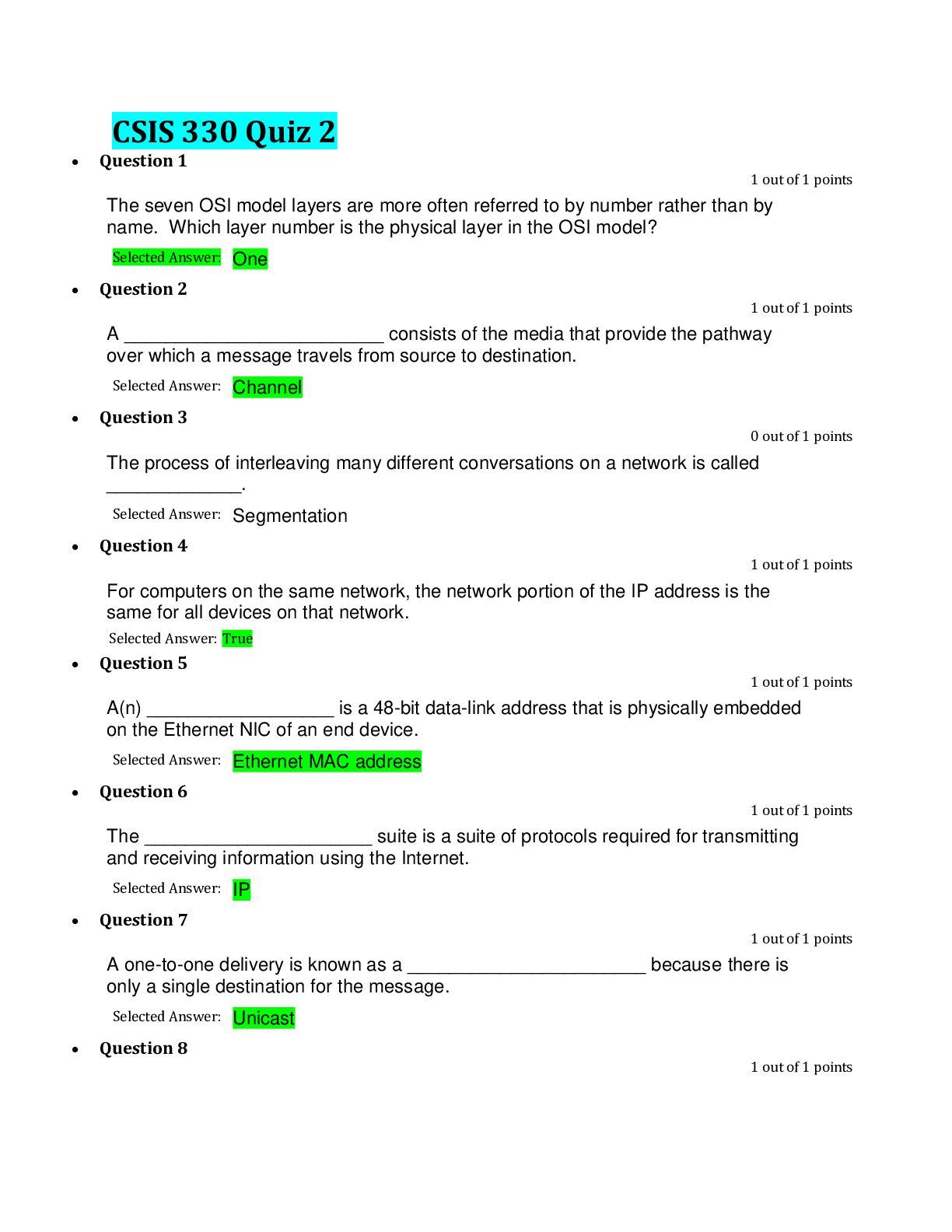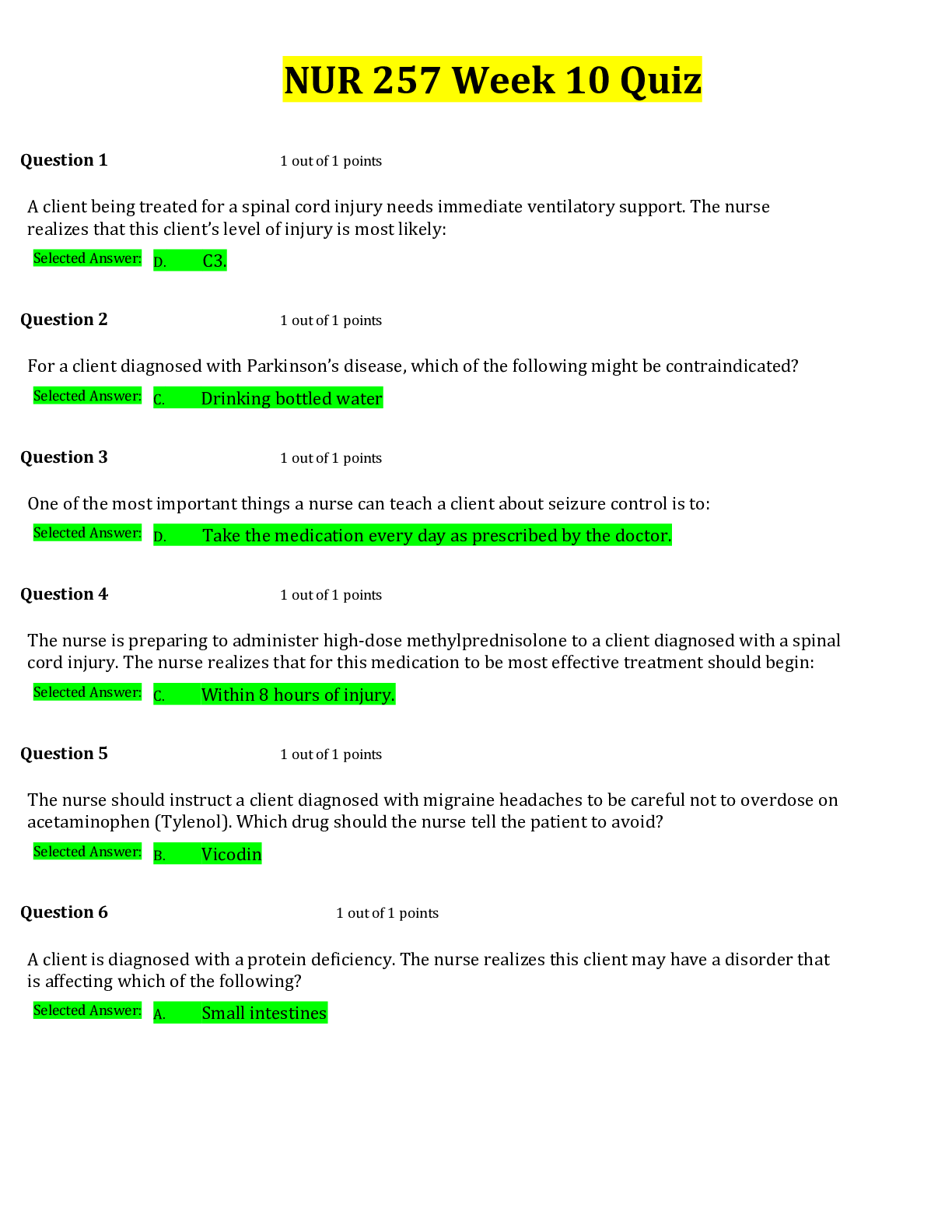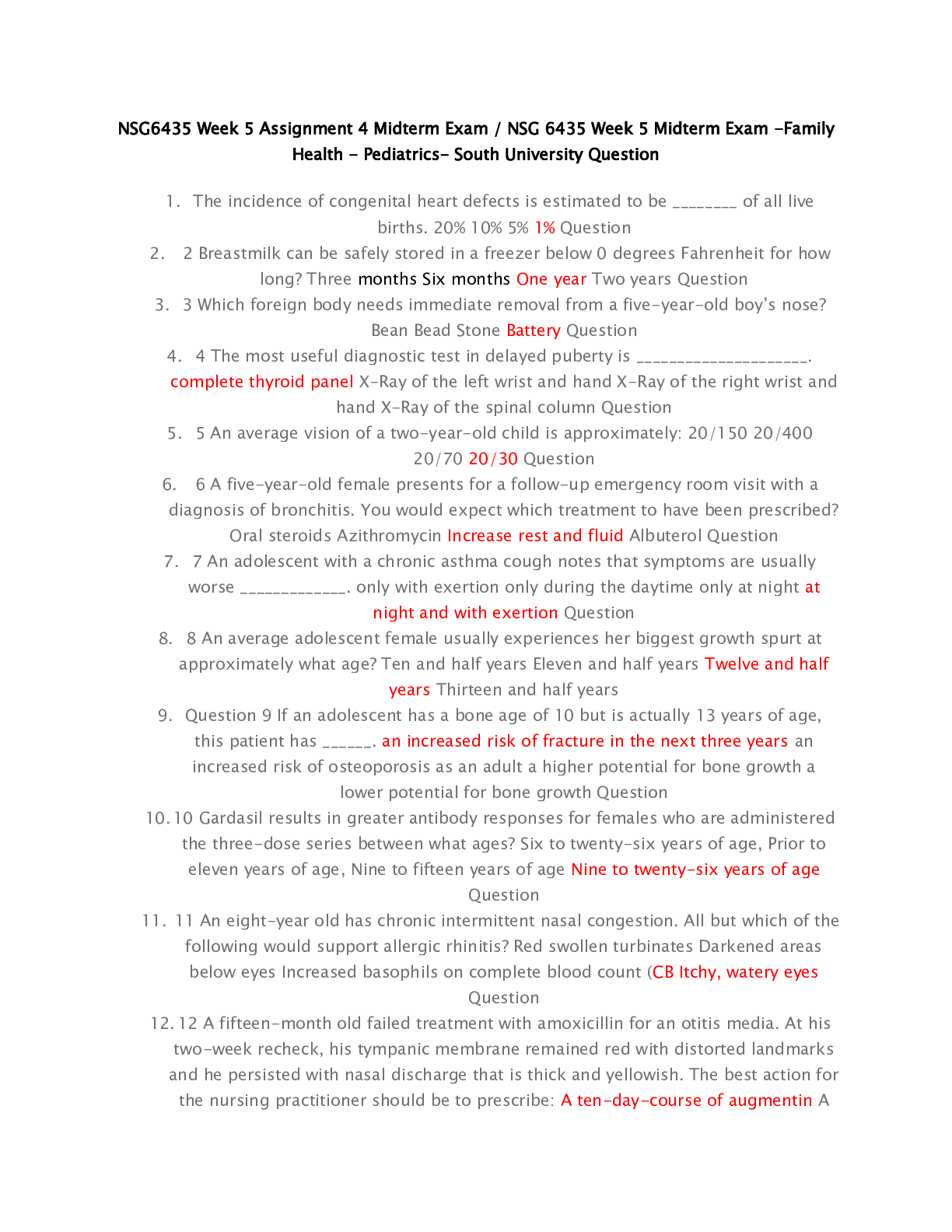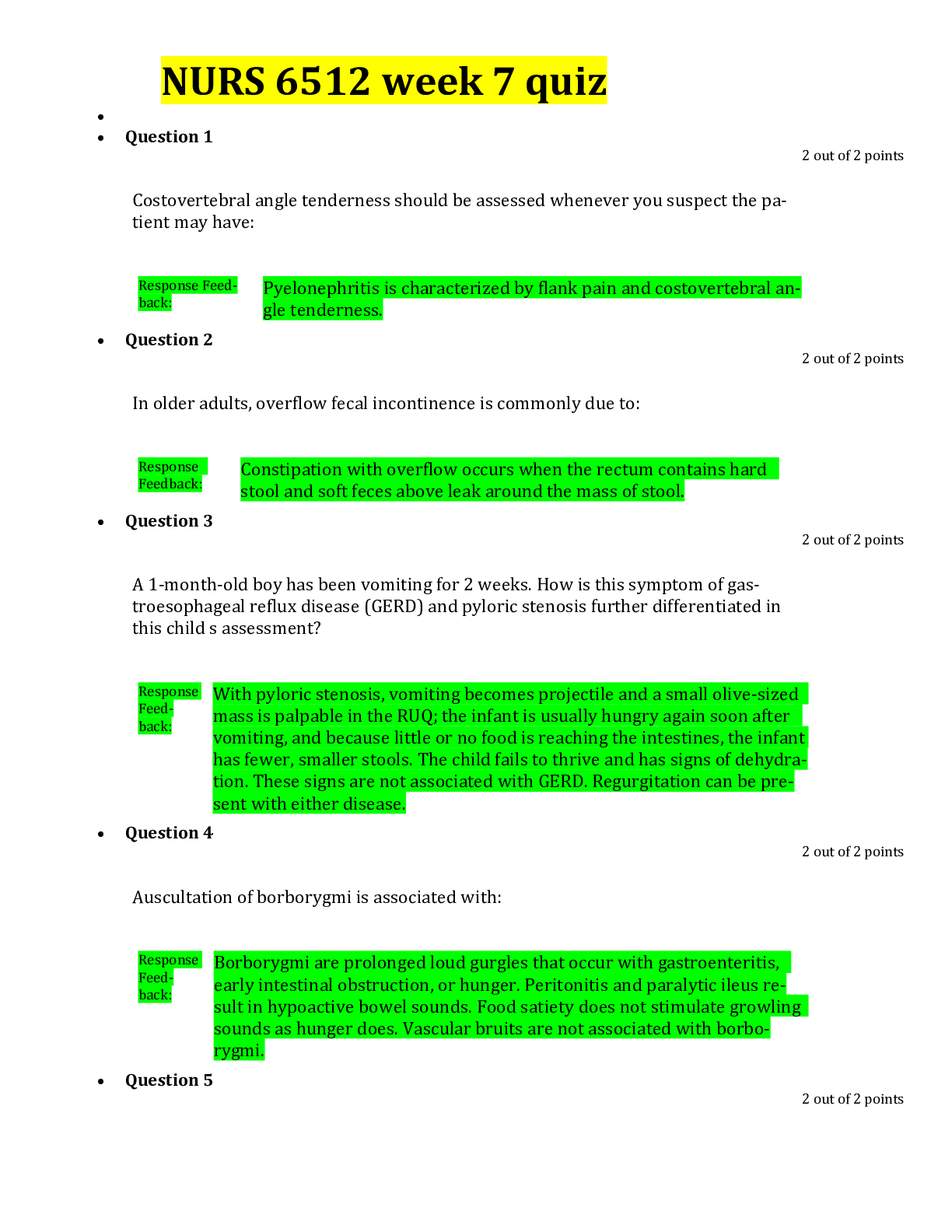Business Administration > QUESTIONS & ANSWERS > Chapter 7--Qualitative Research ( WITH ANSWER KEY ) ALL ANSWERS CORRECT (All)
Chapter 7--Qualitative Research ( WITH ANSWER KEY ) ALL ANSWERS CORRECT
Document Content and Description Below
Chapter 7--Qualitative Research Student: ___________________________________________________________________________ 1. Qualitative research is subjective in the sense that the results are researche... rdependent. True False 2. Quantitative research is especially useful when it is difficult to develop specific and actionable decision statements or research objectives. True False 3. Quantitative research address research objectives through empirical assessments that involve numerical measurement and analytical approaches. True False 4. Qualitative research is objective. True False 5. When different researchers reach different conclusions based on the same interview, the research lacks intersubjective certifiability. True False 6. Qualitative research is cheaper than quantitative research. True False 7. Most exploratory research designs produce qualitative data. True False8. Phenomenology represents a philosophical approach to studying human experiences based on the idea that human experience itself is inherently subjective and determined by the context in which people live. True False 9. A hermeneutic unit refers to a participant in a focus group interview. True False 10. Studying cultures using methods that involve becoming highly active within that culture is called phenomenology. True False 11. Observation is a major way information is gathered in ethnography. True False 12. Phenomenology represents an inductive investigation in which the researcher poses questions about information provided by respondents or taken from historical records. True False 13. Case studies involve documented history of a particular person, group, organization, or event. True False 14. A primary advantage of the case study is that an entire organization or entity can be investigated in depth. True False 15. Case studies are analyzed for important themes identified by the frequency with which the same term arises. True False16. A focus group typically involves a rigid question-and-answer session among participants. True False 17. Focus groups, while useful, take considerable time and effort to execute. True False 18. Leapfrogging is a procedure in which one respondent stimulates thought among the others in a focus group. True False 19. The ideal size of a focus group is 20 to 25 people. True False 20. A focus group moderator needs to be a good talker and dominate the group discussion to keep it on track. True False 21. A focus group discussion guide includes written introductory comments, informing the group about the focus group purpose and rules and then outlines topics or questions to be asked in the group session. True False 22. A focus blog is established for the purpose of collecting qualitative data from an informal, continuous focus group. True False 23. In online focus group sessions, the moderator's ability to probe is greater than it is in a face-to-face focus group session. True False24. Laddering is an approach to probing, asking respondents to compare differences between brands at different levels that produces distinctions at different levels. True False 25. Depth interviews are less expensive than focus group interviews, especially if several depth interviews are conducted. True False 26. The sentence completion method is a type of free-association technique. True False 27. The thematic apperception test (TAT) presents subjects with an ambiguous picture in which consumers and products are the center of attention. True False 28. The term interpretive research is often used to mean qualitative research. True False 29. One advantage of qualitative research is that it is highly replicable. True False 30. The primary barriers to scientific decisions are time, money, and consensus. True False 31. Research that addresses business objectives through techniques allowing the researcher to provide elaborate interpretations of business phenomena without depending on numerical measurement is called _____. A. preliminary research B. primitive research C. qualitative research D. secondary research32. Kodetra is interpreting consumers’ blog postings on the Internet. Which of the following best describes the type of research Kodetra is conducting? A. independent business research B. dependent business research C. quantitative business research D. qualitative business research 33. Qualitative research is considered to be _____ because the researcher must extract meaning from unstructured responses. A. researcher-dependent B. less valid C. less useful D. object-dependent 34. All of the following are situations that often call for qualitative research EXCEPT _____. A. when it is difficult to develop specific and actionable decision statements or research objectives B. when conclusive evidence is desired C. when the research objective is to develop an understanding of some phenomena in great detail and in much depth D. when a fresh approach to studying some problem is needed 35. Research that addresses research objectives through empirical assessments that involve numerical measurement and analysis approaches is called _____. A. quantitative business research B. qualitative business research C. extensive business research D. grounded business research 36. Researcher-dependent results are _____. A. subjective B. objective C. primary D. secondary37. When different researchers reach the same conclusions based on the same interview data, the research is said to have _____. A. validity B. intersubjective certifiability C. subjective validity D. qualitative validity 38. Which type of data are not characterized by numbers and instead are textual, visual, or oral? A. grounded data B. quantitative data C. subjective data D. qualitative data 39. All of the following are qualitative research orientations EXCEPT _____. A. phenomenology B. grounded theory C. case studies D. ANOVA 40. Which qualitative research orientation originated in philosophy and psychology? A. phenomenology B. grounded theory C. ethnography D. anthropology 41. Ethnography is a qualitative research orientation originating in _____. A. marketing B. psychology C. anthropology D. sociology 42. Which qualitative research orientation originated in sociology? A. phenomenology B. grounded theory C. ethnography D. case studies43. Owen is a researcher who studies human experiences based on the idea that it is inherently subjective and determined by the context in which people live. He focuses on how a person’s behavior is shaped by the relationship he or she has with the physical environment, objects, people, and situation. Which qualitative research orientation is Owen using? A. grounded theory B. phenomenology C. ethnography D. case study 44. Which of the following is an important approach used in phenomenology? A. netnography B. ethnography C. grounded theory D. hermeneutics 45. Which of the following is an approach to understanding phenomenology that relies on analysis of texts through which a person tells a story about him- or herself? A. hermeneutics B. ethnography C. psychographics D. psychodynamics 46. A text passage from a respondent’s story that is linked with a key theme from within this story or provided by the researcher is called _____. A. trace element B. schemata C. hermeneutic unit D. case study 47. _____ is a way of studying culture through methods that involve becoming highly active within that culture. A. Grounded theory B. Ethnography C. Phenomenology D. Case studies48. Cindy is an ethnographer who is trying to better understand how mothers take care of toddlers. Being a mother herself, she was able to join a mother’s group and spent considerable time immersed within that culture. From this immersion, she is able to draw data from her observations. Cindy is referred to as a(n) _____. A. interloper B. participant-observer C. moderator D. mystery shopper 49. Which qualitative research orientation extracts a theory from whatever emerges from an area of inquiry? A. phenomenology B. ethnography C. grounded theory D. case study 50. What is the distinguishing characteristic of grounded theory? A. Culture is analyzed by participant-observation in which the researcher becomes “grounded” in the culture over a long period of time. B. It relies on analysis of texts in which a person tells a story about him- or herself. C. The interplay among respondents allows them to piggyback off of each other’s ideas. D. It does not begin with a theory but instead extracts one from whatever emerges from an area of inquiry. 51. _____ represent(s) the documented history of a particular person, group, organization, or event. A. Case studies B. Phenomenology C. netnography D. Attribution theory 52. When Schwinn studies its most successful retailer in depth in order to determine some better ideas for displaying bicycles in its retail stores, this is an example of _____. A. an experiment B. a test market C. a case study D. causal research53. In case studies, _____ are identified by the frequency with which the same term (or a synonym) arises in the narrative description. A. themes B. threats C. links D. ladders 54. An unstructured, free-flowing interview with a small group of people led by a trained moderator is called a(n) _____. A. interaction group interview B. focus group interview C. depth interview D. ethnographic interview 55. Which of the following is the most common size of a focus group? A. 1-2 participants B. 3-5 participants C. 6-10 participants D. 12-20 participants 56. Betsy and six other women are participating in a research study that is an unstructured, free-flowing interview. The researcher asked the group their feelings about how they are treated at work. Betsy is participating in a _____. A. case study B. grounded research study C. depth interview D. focus group interview 57. Which of the following is an advantage of focus group interviews? A. provide multiple perspectives B. low degree of scrutiny C. inexpensive D. easy to use for sensitive topics58. In a focus group discussion, when the comments of one member triggers a stream of comments from the other participants, this is called _____. A. serendipity B. piggyback C. structure D. themes 59. The person who leads a focus group interview and ensures that everyone gets a chance to speak and facilitates discussion is called a(n) _____. A. moderator B. interviewer C. facilitator D. leader 60. Which of the following is a good characteristic for a focus group moderator to possess? A. good listener B. ability to make people feel comfortable so that they will talk in the group C. ability to control discussion without being overbearing D. all of these choices 61. The written set of guidelines that describes an outline of topics to be covered by a focus group moderator is called a _____. A. discussion guide B. TAT test C. concept test D. case study 62. A type of informal, “continuous” focus group established as an Internet blog for the purpose of collecting qualitative data from participants is referred to as a _____. A. net group B. market blog C. focus blog D. focus unit63. Which of the following is a disadvantage of focus groups? A. requires objective, sensitive, and effective moderators B. may not be useful for discussing sensitive topics C. high cost D. all of these choices 64. When a professional interviewer holds a 90-minute discussion with one member of the target market to find out why that respondent purchases a particular brand of clothing, this is an example of a _____. A. depth interview B. concept test C. focus interview D. hermeneutic analysis 65. Which type of qualitative tool is an informal and almost completely unstructured approach in which the researcher engages a respondent in a discussion of the relevant subject matter? A. depth interview B. conversation C. focus group D. free-association 66. Hank is a researcher who is discussing football fan behavior with a respondent. His approach is almost completely unstructured, and he enters into a discussion with few expectations. What he wants is for a respondent to tell him about his or her experience as a football fan. Hank will then try to derive meaning from the resulting dialog. Which qualitative research technique is Hank using? A. conversation B. focus group C. depth interview D. case study 67. All of the following are advantages of semi-structured interviews EXCEPT _____. A. ability to address more specific issues B. responses are usually easier to interpret than other qualitative approaches C. questions are administered without the presence of an interviewer D. high degree of scrutiny68. Which qualitative tool simply records a respondent’s first cognitive reaction (top-ofmind) to some stimulus? A. phenomenology B. conversations C. probing D. free-association techniques 69. When the respondent is presented with: “People who watch football on television are ________,” and asked to fill in the blank, this is an example of a _____. A. word association test B. concept test C. case study D. sentence completion test 70. _____ are the researcher’s descriptions of what actually happens in the field and are the text from which meaning is extracted. A. Hermeneutics B. Field notes C. Discussion guides D. Verbatims 71. Stephanie was asked to look at a picture of a woman sitting on a deserted beach and to describe what was happening in the picture. She was then asked to tell what might happen next. Stephanie was participating in a(n) _____. A. aptitude test B. focus interview C. thematic apperception test D. focus blog 72. Which of the following means the same conclusion would be reached based on another researcher’s interpretation of the research? A. validity B. replicable C. homogeneity D. scrutiny73. Research that addresses marketing objectives through techniques that allow the researcher to provide elaborate interpretations of business phenomena without depending on numerical measurement is referred to as _____ business research. ________________________________________ 74. Qualitative research results are _____ because they are researcher-dependent. ________________________________________ 75. Most exploratory research designs do not usually product _____ data. ________________________________________ 76. Ethnography originated from the discipline of _____. ________________________________________ 77. _____ represents a philosophical approach to studying human experiences based on the idea that human experience itself is inherently subjective and determined by the context in which people live. ________________________________________ 78. The typical ethnographic approach requires the use of _____. ________________________________________ 79. An in-depth study of a major competitor in order to determine how to improve your organization's product line offerings is an example of a(n) _____. ________________________________________ 80. An unstructured, free-flowing discussion with a small group of consumers in a session that is conducted by a moderator is called a(n) ______. ________________________________________ 81. In a focus group, when the comments of one member stimulate another member to say what she is thinking, this is called ________. ________________________________________82. The person who leads a focus group discussion is called a(n) ______. ________________________________________ 83. A written set of guidelines prepared by a moderator that outlines the topics to be discussed in a focus group session is called a(n) ______. ________________________________________ 84. A focus group session that is conducted over the Internet is called a(n) ______ focus group session. ________________________________________ 85. A one-on-one interview between a professional researcher and a research respondent about why she selected a specific insurance benefit option is an example of a(n) ______. ________________________________________ 86. When an interviewer reads a list of words and asks the respondent to “say the first thing that comes to mind after I say each word,” this is an example of a(n) _____ technique. ________________________________________ 87. Research that leads to the same results and conclusions by different researchers is _____. ________________________________________ 88. Compare and contrast qualitative research and quantitative research and discuss situations in which qualitative research is useful.89. Explain the role of qualitative data and quantitative data in exploratory research designs. 90. Name and briefly describe the four qualitative research orientations. 91. Describe a focus group interview and discuss the advantages and disadvantages of this technique. 92. Develop a discussion guide for a focus group on football fan behavior.93. Explain how the Internet is useful in conducting qualitative research. 94. Do exploratory research approaches using qualitative research tools have a role in scientific inquiry? Explain why a decision may be based solely on these results [Show More]
Last updated: 2 years ago
Preview 1 out of 33 pages
.png)
Buy this document to get the full access instantly
Instant Download Access after purchase
Buy NowInstant download
We Accept:

Reviews( 0 )
$12.00
Can't find what you want? Try our AI powered Search
Document information
Connected school, study & course
About the document
Uploaded On
May 18, 2021
Number of pages
33
Written in
Additional information
This document has been written for:
Uploaded
May 18, 2021
Downloads
0
Views
76













